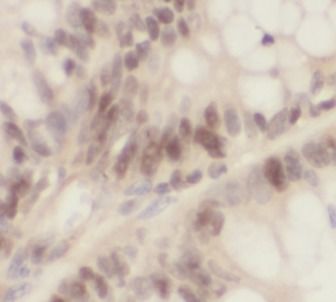Products
XRCC5 antibody
| Synonyms: | X-ray repair cross-complementing protein 5|86 kDa subunit of Ku antigen|ATP-dependent DNA helicase 2 subunit 2|ATP-dependent DNA helicase II 80 kDa subunit|CTC box-binding factor 85 kDa subunit (CTC85 antibody, CTCBF)|DNA repair protein XRCC5|Ku80|Ku86|Lupus Ku autoantigen protein p86|Nuclear factor IV|Thyroid-lupus autoantigen (TLAA)|X-ray repair complementing defective repair in Chinese hamster cells 5 (double-strand-break rejoining)|XRCC5|G22P2 antibody | ||
| Catalogue No.: | FNab09555 | Reactivity: | Human |
| Host: | Rabbit | Tested Application: | ELISA, WB, IHC |
| Clonality: | polyclonal | Isotype: | IgG |
| Size | Price |
|---|---|
| 100µg | Inquiry |
- SPECIFICATIONS
- FIGURES
- CONDITIONS
- FAQS
- Product Name
- XRCC5 antibody
- Catalogue No.
- FNab09555
- Size
- 100μg
- Form
- liquid
- Purification
- Immunogen affinity purified
- Purity
- ≥95% as determined by SDS-PAGE
- Clonality
- polyclonal
- Isotype
- IgG
- Storage
- PBS with 0.02% sodium azide and 50% glycerol pH 7.3, -20℃ for 12 months (Avoid repeated freeze / thaw cycles.)
- Immunogen
- X-ray repair complementing defective repair in Chinese hamster cells 5 (double-strand-break rejoining)
- Alternative Names
- X-ray repair cross-complementing protein 5|86 kDa subunit of Ku antigen|ATP-dependent DNA helicase 2 subunit 2|ATP-dependent DNA helicase II 80 kDa subunit|CTC box-binding factor 85 kDa subunit (CTC85 antibody, CTCBF)|DNA repair protein XRCC5|Ku80|Ku86|Lupus Ku autoantigen protein p86|Nuclear factor IV|Thyroid-lupus autoantigen (TLAA)|X-ray repair complementing defective repair in Chinese hamster cells 5 (double-strand-break rejoining)|XRCC5|G22P2 antibody
- UniProt ID
- P13010
- Observed MW
- 83kDa
- Tested Applications
- ELISA, WB, IHC
- Recommended dilution
- WB: 1:500 - 1:2000; IHC: 1:50 - 1:200
 HepG2 cells were subjected to SDS PAGE followed by western blot with FNab09555(XRCC5 antibody) at dilution of 1:1000
HepG2 cells were subjected to SDS PAGE followed by western blot with FNab09555(XRCC5 antibody) at dilution of 1:1000
 Immunohistochemistry of paraffin-embedded human colon cancer using FNab09555(XRCC5 antibody) at dilution of 1:100
Immunohistochemistry of paraffin-embedded human colon cancer using FNab09555(XRCC5 antibody) at dilution of 1:100
- Background
- The protein encoded by this gene is the 80-kilodalton subunit of the Ku heterodimer protein which is also known as ATP-dependant DNA helicase II or DNA repair protein XRCC5. Ku is the DNA-binding component of the DNA-dependent protein kinase, and it functions together with the DNA ligase IV-XRCC4 complex in the repair of DNA double-strand break by non-homologous end joining and the completion of V(D)J recombination events. This gene functionally complements Chinese hamster xrs-6, a mutant defective in DNA double-strand break repair and in ability to undergo V(D)J recombination. A rare microsatellite polymorphism in this gene is associated with cancer in patients of varying radiosensitivity.
How many times can antibodies be recycled?
First, usually it's not suggested to recycle antibodies. After use, buffer system of antibodies has changed. The storage condition of recycled antibodies for different customers also varies. Thus, the performance efficiency of recycled antibodies can’t be guaranteed. Besides, FineTest ever conducted the antibody recycling assay. Assay results show recycling times of different antibodies also varies. Usually, higher antibody titer allows more repeated use. Customers can determine based on experimental requirements.
Notes: After incubation, we recycle rest antibodies to centrifuge tube and store at 4℃. High titer antibodies can be stored for a minimum of one week. Reuse about three times.
What are components of FineTest antibody buffer?
Components of FineTest antibody buffer are usually PBS with proclin300 or sodium azide, BSA, 50% glycerol. Common preservative is proclin300 or sodium azide, which is widely applied in the lab and industry.
How about the storage temperature and duration of FineTest antibodies?
Most antibodies are stored at -20℃. Directly-labeled flow cytometry antibodies should be stored at 2 - 8℃. The shelf life is one year. If after sales issues for purchased antibodies appear, return or replacement is available. Usually, antibodies can be still used after the one-year warranty. We can offer technical support services.
Is dilution required for FineTest antibodies? What’s the dilute solution?
Directly-labeled flow cytometry antibodies are ready-to-use without dilution. Other antibodies are usually concentrated. Follow the dilution ratio suggested in the manual. Dilute solution for different experiments also varies. Common antibody dilution buffers are acceptable(e.g. PBST, TBST, antibody blocking buffer).
How to retrieve antibodies for immunohistochemistry?
Common retrieval buffers: Tris-EDTA Buffer(pH 9.0); Citrate Buffer(pH 6.0)
Heat induced antibody retrieval:
Method 1: Water-bath heating: Put the beaker with retrieval buffer and slide in the boiling water bath. Keep the boiling state for 15min. Naturally cool to room temperature;
Method 2: Microwave retrieval: Put the beaker with retrieval buffer and slide in the microwave oven. Heat at high power for 5min, Switch OFF for 3min, Heat at medium power for 5min. Naturally cool to room temperature.
How to choose secondary antibodies?
(1) Secondary antibodies react with primary antibodies. Thus, secondary antibodies should be against host species of primary antibodies. E.g. If the primary antibody is derived from rabbit, the relevant secondary antibody should be against rabbit. E.g. goat anti rabbit or donkey anti rabbit.
(2) Choose secondary antibody conjugates according to the experimental type, e.g. ELISA, WB, IHC etc. Common enzyme conjugated secondary antibodies are labelled by HRP, AP etc. Fluorescin or dye labelled secondary antibodies are applied in immunofluorescence and flow cytometry(e.g. FITC, Cy3).
